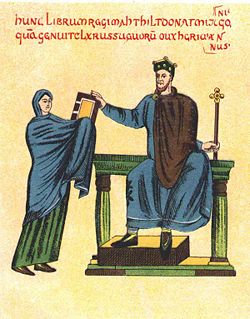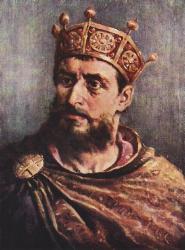Mieszko II Lambert
This article is about a Polish king. See also Duke Mieszko II the Fat.
| Mieszko II Lambert | ||

|
||
| Reign | 1025–1034. | |
| Coronation | December 25, 1025, in Gniezno Cathedral, Poland. | |
| Royal House | Piast. | |
| Coat of Arms | The Piast Eagle. | |
| Parents | Bolesław I the Brave, Enmilda. |
|
| Consorts | Richensa. | |
| Children | With Richensa: Casimir I, Gertruda. |
|
| Date of Birth | 990. | |
| Place of Birth | ? | |
| Date of Death | May 10, 1034. | |
| Place of Death | ? | |
| Place of Burial | Cathedral Basilica of St. Peter and St. Paul, Poznań, Poland. | |
Mieszko II Lambert (990-1034) ruled from 1025-1034 as duke and short-term king of Poland. He was the son of Bolesław I the Brave and Enmilda, daughter of Dobromir, possible Duke of Lusatia. Mieszko II was married to Richensa of Lotharingia (Rixa), the granddaughter of Otto II, Holy Roman Emperor. Their children were Casimir I of Poland, Gertrude of Poland and unknown daughter.
Mieszko II was very well educated for the period. He was able to read and write, and knew both Greek and Latin. He is unjustly known as Mieszko Gnuśny (the "Lazy," "Stagnant" or "Slothful"). He received that epithet due to the unfortunate way his reign ended; but at the beginning he acted as a skillful and talented ruler. He sought to rule as king in 1025, he probably served as his father's governor in Kraków, most likely from 1013, and reputedly built many churches.
Beginning in 1028, he successfully waged war against the Holy Roman Empire: he was able to repel the its invading army, and later even invaded Saxony. He allied Poland with Hungary, resulting in a temporary Hungarian occupation of Vienna. This war was probably prompted by family connections of Mieszko's in Germany who opposed Emperor Conrad II.

An understanding of what happened later requires an understanding of Mieszko's family. His older brother Bezprym was the son of an unknown Hungarian wife of Bolesław's and was later expelled by Mieszko. He also had a younger brother, Otton. By Slavic custom, a father should divide his legacy among all his sons. However, since a kingdom cannot be divided, Mieszko's brothers received nothing from their father's legacy.
As Bezprym was the oldest son, many probably felt that he should have succeeded his father as king. Bezprym had, however, always been disliked by his father, as indicated by his name (the Piasts tended to give names such as Bolesław, Mieszko and later Kazimierz, Władysław and emperors' names such as Otto, Conrad and Heinrich: Bezprym was a commoner's name, which implied that Bolesław did not wish Bezprym to succeed him). He was packed off to a monastery.
Mieszko's two brothers escaped abroad: Otton to HRE, Bezprym to Kievan Rus. Soon after, the HRE emperor and the grand duke of Kiev, Yaroslav I the Wise, made alliance and simultaneously invaded Poland.
Facing two enemies, HRE on the west and Rus on the east, Mieszko escaped to Bohemia.Bezprym began his reign by sending his crown and regalia to HRE. Mieszko soon returned, but was forced to pledge fealty to the German Emperor, and Poland was divided among him, his brothers Otton and Bezprym, and a certain Thiedric (cousin, grandson of Mieszko I and Oda). Otton was killed by one of his own men, and Mieszko was able to reunite Poland.
What happened next is a mystery. Historians now think that Mieszko was killed (1034) in a plot hatched by the aristocracy.
After Mieszko's death, Poland's peasants revolted in a "pagan reaction." The exact reasons and date are unknown. Mieszko's son, Casimir I, was either expelled by this insurrection, or the insurrection was caused by the aristocracy's expulsion of him.
Some modern historians argue that the insurrection was caused more by economic than by religious issues, such as new taxes for the Church and the militarization of the early Polish polity. Priests, monks and knights were killed; cities, churches and monasteries were burned.
The chaos became still greater when unexpectedly the Czechs invaded from the south. The land became divided among local rulers, one of whom is known by name: Masław, ruler of Masovia. Greater Poland was so devastated that it ceased to be the core of Polish Kingdom. The capital was moved to Kraków in Lesser Poland.
See also
|
||||||||||||||||||||||||||